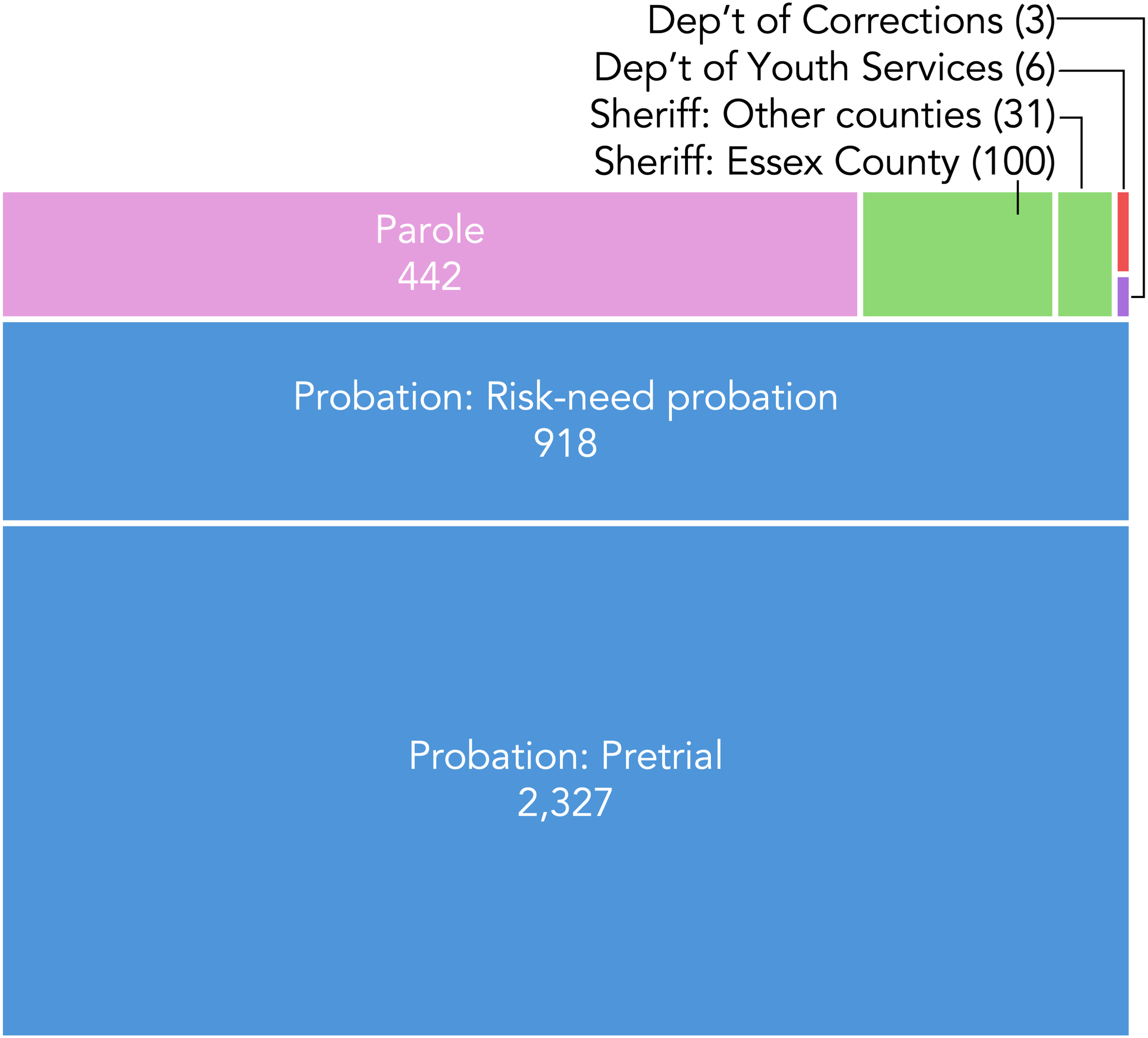E-Carceration
The Impact of GPS Monitoring in the Massachusetts Criminal and Juvenile Legal Systems
october 2025
This report examines the use of court- and other justice system actor-ordered Global Positioning System (GPS) monitoring in the Massachusetts juvenile and adult criminal legal systems. GPS monitoring (sometimes called electronic monitoring or “ELMO”) is used to enforce curfews, house arrest and geographic exclusions, as well as to provide real time information about a person’s location to state authorities. Monitoring is accomplished through a battery-powered device, worn on the ankle or wrist, which individuals cannot remove without incurring additional legal liability.
Select Findings
Widespread use
On any given day, approximately 3,800 individuals in Massachusetts are monitored by GPS devices through state and county systems, including more than 200 children in the community pre-trial. The population subject to GPS monitoring reached record high levels from 2019–2022 before declining slightly in recent years. GPS monitoring can be imposed throughout the criminal and juvenile legal processes, from arrest to release from incarceration, and it can last for months or years. While GPS monitoring is often viewed as an alternative to placing a person in a locked facility, it is sometimes ordered and placed on individuals who do not require any coercive state monitoring.
GPS monitoring throughout the legal process
Opaque administration by private vendors
Massachusetts agencies accomplish GPS monitoring through contracts with private companies. This makes it difficult for the agencies, especially the Massachusetts Probation Service (MPS), to collect and transparently share data with the public about the population subject to monitoring.
Problems with administration in Massachusetts
There are several problems with GPS monitoring as practiced in the Commonwealth. First, decisionmakers—including judges and parole board members—impose monitoring too frequently, at times without justification or oversight. Second, decisionmakers impose monitoring for long durations without regard for the harmful effects of prolonged monitoring. Third, GPS monitoring is accompanied by a long list of requirements that are difficult for people to adhere to, leading to frequent “technical” violations of their release from custody. Fourth, the technology used to carry out monitoring is often defective and causes both technical violations and significant disruption to the lives of monitored people.
Daily GPS monitoring population, 2024–2025 (Total=3,827)
Problems intrinsic to technology
The inherent disruption of everyday life caused by GPS monitoring is enormous—and difficult to appreciate without hearing a person’s firsthand experience. Interviews show that GPS monitoring causes serious harm to the mental, physical, and socioeconomic health of individuals subjected to it. Additionally, GPS monitoring invades privacy, restricts mobility, and stigmatizes individuals, creating barriers to social reintegration. Monitored individuals report facing difficulties securing jobs, attending school and participating in extracurricular activities due to movement restrictions and the visibility of GPS monitors. Frequent technical violations, such as battery failures or accidental strap tampering, expose individuals to legal consequences, including arrest, detention and additional sanctions.
Youth-specific harms
Young people subject to coerced GPS monitoring are particularly vulnerable to its negative effects because GPS monitoring and its related restrictions hinder critical development in their formative years. Disruptions include loss of healthy peer relationships, interruptions of education, loss of mentorship opportunities and loss of emotional and financial support.
Juvenile GPS monitoring population by type under MPS contract, October 8, 2024 (total 217)
Select Recommendations
Understand and treat GPS monitoring as a type of incarceration
Legal and policy frameworks should incorporate safeguards for both GPS monitoring and incarceration to ensure that individuals are subject to the least restrictive environment possible given the overall circumstances of the case, that GPS monitoring is only used when necessary and for the shortest duration possible and invest in systems that will prevent the need for incarceration of any form, including monitoring.
Reduce the frequency and duration of GPS monitoring over time by prioritizing non-carceral alternatives
Courts and youth-serving institutions should prioritize alternatives to incarceration and to GPS monitoring, with the goal of decreasing the overall monitored population over time.
Address technology failures and excessive conditions that cause unnecessary harm
The agencies implementing GPS monitoring should regularly solicit feedback from people on GPS monitors and address the serious harms that result from excessive conditions and frequent technological failures, neither of which are necessary to achieve the stated purposes of GPS monitoring.
Improve Transparency and Data Collection
State agencies including the MPS should establish standardized processes for collecting and sharing detailed data on the usage of GPS monitors, conditions, and outcomes to enable informed policy decisions and public oversight.




